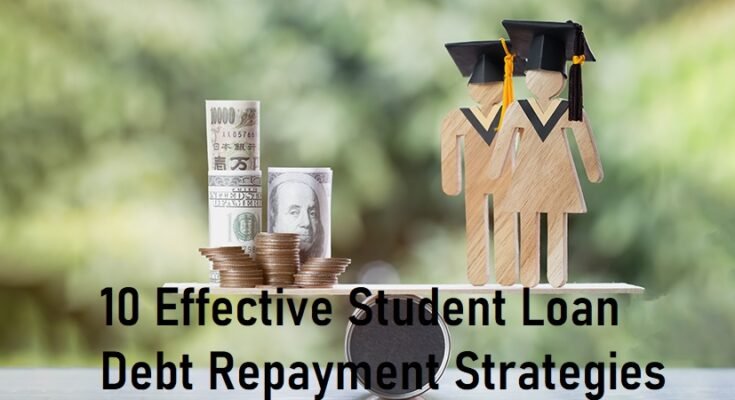Student loan debt significantly burdens many individuals, impacting their financial stability and future planning. In the United States, student loan debt exceeds $1.7 trillion, with millions of borrowers striving to manage and repay their loans. With a hypothetical $5,000 student loan as our example, we will explore ten effective strategies for repaying this debt. These strategies provide a comprehensive guide to student loan debt repayment strategies. By understanding and implementing these strategies, borrowers can take control of their financial future.
10 Effective Student Loan Debt Repayment Strategies
1. Standard Repayment Plan
The Standard Repayment Plan is the default option for federal student loans. It involves fixed monthly payments over ten years. This plan is designed to pay off the loan in a reasonable amount of time, though the monthly payments might be higher than other plans.
Payment Breakdown: Let’s break it down with an example. Imagine you have a $5,000 loan with a 5% interest rate. Under the Standard Repayment Plan, your monthly payment would be around $53. This fixed amount helps you know exactly what to expect every month, making budgeting easier.
Time Period: You’ll be making these payments for ten years. This might seem like a long time, but it’s set up to ensure you pay off your loan in a manageable timeframe without dragging on for decades.
Pros:
- Predictable Payments: One of the biggest advantages is predictability. You’ll pay the same amount every month, which can make financial planning simpler.
- Reasonable Timeframe: Paying off your loan in ten years means you’re not carrying debt forever. It strikes a balance between not rushing you and not letting it linger.
Cons:
- Higher Monthly Payments: The fixed payments can be higher than those in other repayment plans, especially if you have a larger loan. This might be a challenge if your income is low or variable.
- Limited Flexibility: There’s not much wiggle room in this plan. If you face financial hardship, it doesn’t adjust your payment amount.
Must Read: 12 Best Tips for Saving Money on Groceries in 2024
2. Graduated Repayment Plan
The Graduated Repayment Plan is designed to help borrowers manage their student loan payments more easily, especially if they expect their income to grow over time. This plan starts with lower monthly payments that increase every two years, allowing borrowers to start with manageable payments and gradually pay more as they earn more.
Payment Breakdown: When you first start on the Graduated Repayment Plan, your payments might be as low as $30 per month. Every two years, these payments will increase. By the end of the 10-year repayment period, your payments will be higher than what you would pay under a Standard Repayment Plan.
Time Period: The plan spans 10 years, the same as the Standard Repayment Plan. However, the difference lies in how the payments are structured over this period.
Pros:
- Easier Start: One of the biggest advantages is that your initial payments are low. This can be a huge relief when you’re just starting your career and might not be earning a high salary yet.
- Income Growth: If you expect your income to increase over time, this plan aligns well with your financial growth. As you earn more, you can handle the increased payments more comfortably.
Cons:
- More Interest: Because you start with lower payments, it takes longer to reduce the principal balance on your loan. This means you’ll end up paying more in interest over the life of the loan compared to the Standard Repayment Plan.
3. Income-Driven Repayment Plan
Income-Driven Repayment (IDR) plans are designed to make student loan payments more manageable by adjusting the monthly amount based on your income and family size. This means if your income is low or you have a large family, your payments will be smaller. There are several types of IDR plans, including Income-Based Repayment (IBR), Pay As You Earn (PAYE), and Revised Pay As You Earn (REPAYE).
Payment Breakdown: With IDR plans, your monthly payments are usually between 10% and 20% of your discretionary income. Discretionary income is the amount of money you have left after covering necessary expenses like housing and food.
Time Period: These plans extend the repayment period to 20 to 25 years. If you still have a balance on your loan at the end of this period, it might be forgiven. This means you won’t have to pay back the remaining amount, although you may have to pay taxes on the forgiven amount.
Pros:
- Adjusts with Income: One of the biggest benefits is that your payments can go up or down based on how much you earn. This can make it easier to manage your finances during periods of low income.
- Potential for Loan Forgiveness: After making payments for 20 or 25 years, you might be eligible to have the remaining loan balance forgiven.
Cons:
- Extended Repayment Period: Since you’re spreading out payments over a longer time, you’ll end up paying more in interest compared to a standard repayment plan.
- Potential Tax Consequences: If you receive loan forgiveness, the forgiven amount might be considered taxable income, meaning you could owe taxes on it.
4. Pay More Than the Minimum
One of the best ways to tackle student loan debt is by paying more than the minimum required amount each month. This strategy can significantly reduce the overall interest you pay and shorten the repayment period, helping you become debt-free faster.
How It Works:
When you make extra payments towards your loan principal, you’re directly reducing the amount of debt on which interest is calculated. Even small additional payments can have a big impact over time. For example, if your minimum payment is $53 per month and you decide to pay $100 instead, you’ll cut down your repayment period significantly.
Example Breakdown:
Imagine you owe $5,000 on your student loan with an interest rate of 5%. If you stick to the minimum payment of $53, it will take you about 10 years to repay the loan, and you’ll end up paying a lot in interest. However, if you pay $100 each month, you’ll be done in approximately 5 years and save a significant amount in interest.
Pros:
- Reduces Interest Costs: By paying more than the minimum, you reduce the principal faster, which in turn reduces the total interest you pay over the life of the loan.
- Quicker Debt Elimination: Extra payments help you clear your debt faster, giving you financial freedom sooner.
Cons:
- Requires Extra Financial Discipline: Committing to paying more than the minimum each month requires careful budgeting and financial discipline. It might mean cutting back on other expenses or finding ways to increase your income.
5. Biweekly Payments
Managing student loan debt can be challenging, but there are effective strategies to make it easier. One such strategy is biweekly payments. Instead of making one payment per month, you split your monthly payment in half and pay every two weeks. This might sound like a small change, but it has a big impact over time.
How Biweekly Payments Work
Let’s break it down: if your monthly payment is $53, you pay $26.50 every two weeks. Since there are 52 weeks in a year, you end up making 26 half-payments, or 13 full payments, instead of the usual 12. This extra payment helps you pay off your loan faster and reduces the amount of interest you pay.
Benefits of Biweekly Payments
- Reduced Interest: By paying more frequently, less interest accumulates on your loan. This means you pay less over the life of the loan.
- Faster Repayment: That extra payment each year shortens your repayment period. Instead of taking 10 years, you might pay off your loan in about 9 years.
Things to Consider
While biweekly payments can save you money and time, they do require careful budgeting and tracking. Here are some points to keep in mind:
- Budgeting: You need to ensure you have the funds available every two weeks, which might be different from your usual monthly budgeting.
- Tracking: Keep a close eye on your payments to ensure they are processed correctly and credited to your account.
Is It Worth It?
If you’re committed to reducing your debt faster and paying less in interest, biweekly payments can be a great option. It’s a simple adjustment that can lead to significant savings. Plus, you’ll enjoy the satisfaction of being debt-free sooner than expected.
6. Refinancing the Loan
Refinancing your student loan involves replacing your current loan with a new one, typically at a lower interest rate. This strategy can be especially beneficial if you have a good credit score, which makes you eligible for better rates.
How Refinancing Works:
When you refinance, you take out a new loan with a private lender to pay off your existing student loan. The new loan usually comes with a lower interest rate, which can help reduce your monthly payments.
Example Scenario:
Let’s say you refinance your loan and secure a lower interest rate. Instead of paying $200 a month, your new payment might be $145. Over time, this reduction in your monthly payments can lead to significant savings.
Repayment Terms:
The length of your new loan term can vary. For example, if you choose a 7-year repayment plan, you’ll have 7 years to pay off the refinanced loan. The term length will affect your monthly payment amount—the longer the term, the lower your monthly payments, but the more interest you’ll pay over the life of the loan.
Pros:
- Lower Interest Rate: The primary benefit is a lower interest rate, which can save you money over time.
- Reduced Monthly Payments: With a lower interest rate, your monthly payments may decrease, giving you more financial flexibility.
Cons:
- Good Credit Required: To qualify for the best rates, you’ll need a good credit score. If your credit score is low, you might not be eligible for refinancing, or you might not get a significantly lower rate.
- Loss of Federal Benefits: Refinancing federal student loans with a private lender means losing federal loan benefits, such as income-driven repayment plans and loan forgiveness programs.
7. Lump-Sum Payments
One effective strategy for paying off student loans faster is making lump-sum payments. This means using extra money from tax refunds, work bonuses, or other unexpected financial gains to pay down your loan balance. By putting these windfalls toward your student loan, you can significantly reduce the principal amount you owe. This not only helps you save a lot on interest over time but also shortens the overall repayment period.
How It Works:
Each year, you might get a tax refund or a bonus from work. Instead of spending that money on something else, you could decide to put it toward your student loan. For example, if you receive a $1,000 tax refund, you could make a $1,000 lump-sum payment on your loan. This reduces the principal amount, which is the original amount you borrowed.
Pros:
- Reduces Principal Quickly: By applying extra money directly to your loan’s principal, you lower the amount on which interest is calculated. This can lead to paying off your loan much faster.
- Less Interest Paid: Since your interest is based on the principal amount, reducing the principal with lump-sum payments means you will pay less interest over the life of the loan.
Cons:
- Requires Discipline: It can be tempting to spend tax refunds or bonuses on other things. Applying these windfalls to your student loan requires self-control and a commitment to your repayment plan.
- Irregular Payments: Lump-sum payments are often not regular and depend on when you receive extra money. This means you can’t always count on having extra funds to put toward your loan each year.
8. Utilizing Employer Assistance
One effective way to tackle your student loan debt is by taking advantage of employer assistance programs. Many companies now offer student loan repayment benefits as part of their perks package, which can be a game-changer for your finances. Let’s break down how this works and what you need to know.
How It Works: With employer assistance, your company helps you pay down your student loans. For example, imagine your employer contributes $100 a month towards your loan. This might not seem like a huge amount, but it adds up over time and can significantly ease your financial load.
Time Period: The length of time you can receive this assistance depends on your employer’s policy. Many companies offer this benefit for up to 5 years, which can help you make a dent in your student loan balance over time.
Pros:
- Reduces Your Financial Burden: The most obvious benefit is that your employer is helping you with your loan payments. This can free up your budget for other expenses or savings goals.
- Accelerates Repayment: With extra payments coming in from your employer, you can pay off your loans faster. This means you’ll be debt-free sooner than if you were paying only on your own.
Cons:
- Dependent on Employer Policy: Not all employers offer this benefit, and the amount and duration can vary. If your company doesn’t offer it, you won’t be able to take advantage of this opportunity.
- May Have Conditions: Some programs might have requirements, like staying with the company for a certain period. Be sure to read the fine print so you understand what you’re committing to.
9. Automating Payments
One effective way to manage your student loan payments and save a bit of money is by setting up automatic payments. Many lenders offer a small but valuable benefit for choosing this option: a 0.25% reduction in your interest rate. This might seem like a tiny amount, but over time, it can add up to real savings.
Here’s how it works:
When you automate your payments, your loan payments are deducted directly from your bank account every month. This means you don’t have to remember to make the payment or worry about missing a due date. Because you’re always on time, your credit score can improve, which is great for your financial health in the long run.
For example, if you’re paying $53 a month on your student loan, automating your payments can slightly reduce this amount due to the lower interest rate. Over 10 years, this small reduction can make a noticeable difference.
Pros:
- Easier Management: Setting up automatic payments means you won’t have to manually pay each month. It’s one less thing to worry about!
- Interest Savings: The 0.25% reduction in interest may not seem like much, but over time, it can lead to substantial savings.
- Improved Credit Score: On-time payments can boost your credit score, helping you with future financial goals.
Cons:
- Account Balance: You need to keep enough money in your account to cover the payments. If you don’t, you could miss a payment and face late fees.
- Less Control: You have less control over your payment schedule and amount, which could be a drawback if your financial situation changes.
10. Snowball Method
One effective way to manage your student loan debt is the Snowball Method. This strategy focuses on paying off your smallest debts first and then using those freed-up payments to tackle larger ones. Here’s how it works and why it might be the right approach for you.
How It Works
Start by listing all your student loans from the smallest to the largest balance. Make minimum payments on all your loans except for the smallest one. Put any extra money you can afford toward this smallest loan. Once it’s paid off, take the amount you were putting toward that loan and apply it to the next smallest loan on your list. Continue this process, building momentum as you pay off each debt.
Why It’s Effective
The Snowball Method is not just about numbers; it’s about motivation. When you see those smaller debts disappearing, you get a sense of accomplishment. This quick win boosts your confidence and keeps you motivated to tackle the bigger loans. It’s like building a snowball that gets bigger and bigger as it rolls down a hill!
Pros: The biggest advantage of the Snowball Method is the psychological boost you get from paying off loans quickly. Each time you eliminate a debt, you gain a sense of achievement that can keep you motivated throughout your repayment journey.
Cons: On the downside, this method might not save you as much on interest compared to other strategies, like the Avalanche Method, which targets the highest-interest loans first. However, the emotional and psychological benefits can outweigh this drawback for many people.
Conclusion
Effectively managing student loan debt requires understanding the available repayment strategies and choosing the one that best fits your financial situation. By exploring options such as standard repayment plans, income-driven plans, refinancing, and additional payments, borrowers can take proactive steps to reduce their debt burden. It’s important to evaluate each strategy’s pros and cons and consider seeking advice from a financial advisor to tailor a repayment plan that meets individual needs.




